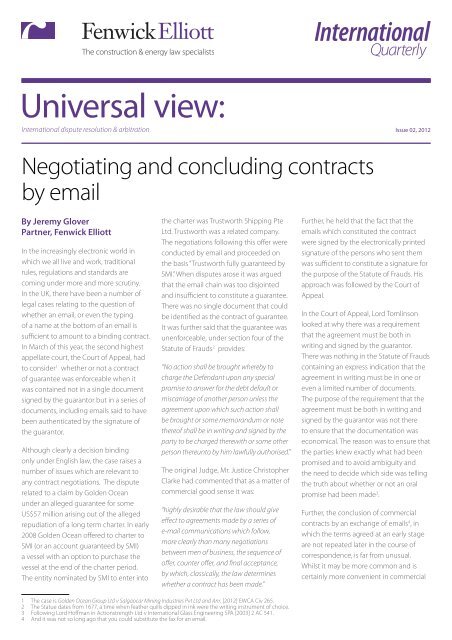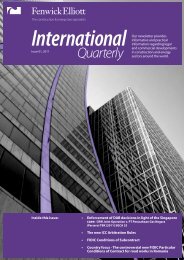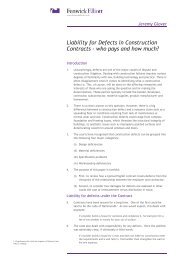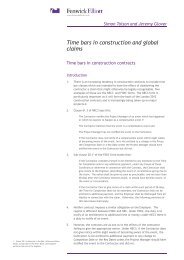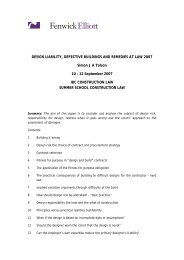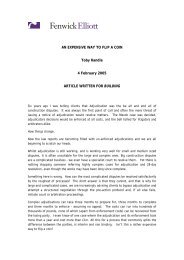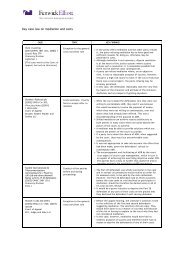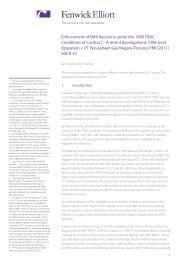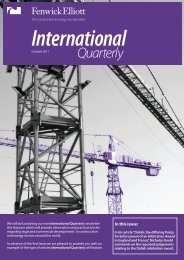download PDF - Fenwick Elliott
download PDF - Fenwick Elliott
download PDF - Fenwick Elliott
Create successful ePaper yourself
Turn your PDF publications into a flip-book with our unique Google optimized e-Paper software.
Universal view:<br />
International dispute resolution & arbitration<br />
Issue 02, 2012<br />
Negotiating and concluding contracts<br />
by email<br />
By Jeremy Glover<br />
Partner, <strong>Fenwick</strong> <strong>Elliott</strong><br />
In the increasingly electronic world in<br />
which we all live and work, traditional<br />
rules, regulations and standards are<br />
coming under more and more scrutiny.<br />
In the UK, there have been a number of<br />
legal cases relating to the question of<br />
whether an email, or even the typing<br />
of a name at the bottom of an email is<br />
sufficient to amount to a binding contract.<br />
In March of this year, the second highest<br />
appellate court, the Court of Appeal, had<br />
to consider 1 whether or not a contract<br />
of guarantee was enforceable when it<br />
was contained not in a single document<br />
signed by the guarantor but in a series of<br />
documents, including emails said to have<br />
been authenticated by the signature of<br />
the guarantor.<br />
Although clearly a decision binding<br />
only under English law, the case raises a<br />
number of issues which are relevant to<br />
any contract negotiations. The dispute<br />
related to a claim by Golden Ocean<br />
under an alleged guarantee for some<br />
US$57 million arising out of the alleged<br />
repudiation of a long term charter. In early<br />
2008 Golden Ocean offered to charter to<br />
SMI (or an account guaranteed by SMI)<br />
a vessel with an option to purchase the<br />
vessel at the end of the charter period.<br />
The entity nominated by SMI to enter into<br />
the charter was Trustworth Shipping Pte<br />
Ltd. Trustworth was a related company.<br />
The negotiations following this offer were<br />
conducted by email and proceeded on<br />
the basis “Trustworth fully guaranteed by<br />
SMI.” When disputes arose it was argued<br />
that the email chain was too disjointed<br />
and insufficient to constitute a guarantee.<br />
There was no single document that could<br />
be identified as the contract of guarantee.<br />
It was further said that the guarantee was<br />
unenforceable, under section four of the<br />
Statute of Frauds 2 provides:<br />
“No action shall be brought whereby to<br />
charge the Defendant upon any special<br />
promise to answer for the debt default or<br />
miscarriage of another person unless the<br />
agreement upon which such action shall<br />
be brought or some memorandum or note<br />
thereof shall be in writing and signed by the<br />
party to be charged therewith or some other<br />
person thereunto by him lawfully authorised.”<br />
The original Judge, Mr. Justice Christopher<br />
Clarke had commented that as a matter of<br />
commercial good sense it was:<br />
“highly desirable that the law should give<br />
effect to agreements made by a series of<br />
e-mail communications which follow,<br />
more clearly than many negotiations<br />
between men of business, the sequence of<br />
offer, counter offer, and final acceptance,<br />
by which, classically, the law determines<br />
whether a contract has been made.”<br />
Further, he held that the fact that the<br />
emails which constituted the contract<br />
were signed by the electronically printed<br />
signature of the persons who sent them<br />
was sufficient to constitute a signature for<br />
the purpose of the Statute of Frauds. His<br />
approach was followed by the Court of<br />
Appeal.<br />
In the Court of Appeal, Lord Tomlinson<br />
looked at why there was a requirement<br />
that the agreement must be both in<br />
writing and signed by the guarantor.<br />
There was nothing in the Statute of Frauds<br />
containing an express indication that the<br />
agreement in writing must be in one or<br />
even a limited number of documents.<br />
The purpose of the requirement that the<br />
agreement must be both in writing and<br />
signed by the guarantor was not there<br />
to ensure that the documentation was<br />
economical. The reason was to ensure that<br />
the parties knew exactly what had been<br />
promised and to avoid ambiguity and<br />
the need to decide which side was telling<br />
the truth about whether or not an oral<br />
promise had been made 3 .<br />
Further, the conclusion of commercial<br />
contracts by an exchange of emails 4 , in<br />
which the terms agreed at an early stage<br />
are not repeated later in the course of<br />
correspondence, is far from unusual.<br />
Whilst it may be more common and is<br />
certainly more convenient in commercial<br />
1 The case is Golden Ocean Group Ltd v Salgaocar Mining Industries Pvt Ltd and Anr, [2012] EWCA Civ 265.<br />
2 The Statue dates from 1677, a time when feather quills dipped in ink were the writing instrument of choice.<br />
3 Following Lord Hoffman in Actionstrength Ltd v International Glass Engineering SPA [2003] 2 AC 541.<br />
4 And it was not so long ago that you could substitute the fax for an email.


